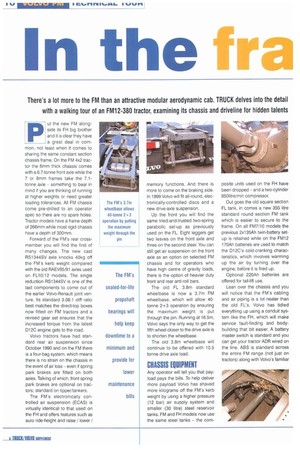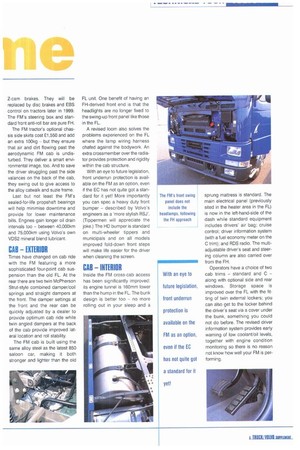n the
Page 110

Page 111

If you've noticed an error in this article please click here to report it so we can fix it.
There's a lot more to the FM than an attractive modular aerodynamic cab. TRUCK delves into the detail with a walking tour of an FM12-380 tractor, examining its chassis and driveline for hidden talents
ut the new FM alongside its FH big brother and it is clear they have a great deal in common, not least when it comes to sharing the same constant section chassis frame. On the FM 4x2 tractor the 6mm thick chassis comes with a 6.7-tonne front axle while the 7 or 8mm frames take the 7.1tonne axle something to bear in mind if you are thinking of running at higher weights or need greater loading tolerances. All FM chassis come pre-drilled to an operator spec so there are no spare holes. Tractor models have a frame depth of 266mm while most rigid chassis have a depth of 300mm.
Forward of the FM's rear crossmember you will find the first of many changes. The new cast RS1344SV axle knocks 40kg off the FM's kerb weight compared with the old RAEV85/91 axles used on FL10/12 models. The single reduction RS1344SV is one of the last components to come out of the earlier Volvo-Renault joint venture, Its standard 3.08:1 diff ratio best matches the direct-top boxes now fitted on FM tractors and a revised gear set ensures that the increased torque from the latest D12C engine gets to the road.
Volvo tractors have had standard rear air suspension since October 1990 and on the FM there is a four-bag system,which means there is no strain on the chassis in the event of air loss even if spring park brakes are fitted on both axles, Talking of which, front spring park brakes are optional on tractors: standard on tipper/tankers.
The FM's electronically controlled air suspension (ECAS) is virtually identical to that used on the FH and offers features such as auto ride-height and raise / lower / memory functions. And there is more to come on the braking side. In 1999 Volvo will tit all-round, electronically-controlled discs and a new drive-axle suspension.
Up the front you will find the same tried-and-trusted two-spring parabolic set-up as previously used or the FL. Eight loggers get two leaves on the front axle and three on the second steer. You can still get air suspension on the front axle as an option on selected FM chassis and for operators who have high centre of gravity loads, there is the option of heavier duty front and rear anti-roll bars.
The old FL 3.8m standard wheelbase is now a 3.7m FM wheelbase, which will allow 40tonne 2+3 operation by ensuring the maximum weight is put through the pin. Running at 16.5m, Volvo says the only way to get the fifth wheel closer to the drive axle is to shorten the wheelbase.
The old 3.8m wheelbase will continue to be offered with 10.5 tonne drive axle load.
CHASSIS EQUIPMENT
Any operator will tell you that payload pays the bills. To help deliver more payload Volvo has shaved more kilograms off the FM's kerb weight by using a higher pressure (12 bar) air supply system and smaller (30 litre) steel reservoir tanks. FM and FH models now use the same steel tanks the corn posite units used or the FH have been dropped and a two-cylinder 8501itre/min compressor.
Out goes the old square section FL tank, in comes a new 355 litre standard round section FM tank which is easier to secure to the frame. On all FM7/10 models the previous 2x135Ah twin-battery setup is retained while on the FM12 170Ah batteries are used to match the D12C's cold-cranking characteristics, which involves warming up the air by turning over the engine, before it is fired up.
Optional 220Ah batteries are offered for tail-lift use.
Lean over the chassis and you will notice that the FM's cabling and air piping is a lot neater than the old FL's. Volvo has tidied everything up using a conduit system like the FH. which will make service fault-finding and bodybuilding that bit easier. A battery master switch is standard and you can get your tractor ADFt wired on the line, ABS is standard across the entire FM range (not just on tractors) along with Volvo's familiar Z-cam brakes. They will be replaced by disc brakes and EBS control on tractors later in 1999. The FM's steering box and standard front anti-roll bar are pure FH.
The FM tractor's optional chassis side skirts cost 21,550 and add an extra 100kg but they ensure that air and dirt flowing past the aerodynamic FM cab is undisturbed. They deliver a smart environmental image, too. And to save the driver struggling past the side valances on the back of the cab, they swing out to give access to the alloy catwalk and suzie frame.
Last but not least the FM's sealed-for-life propshaft bearings will help minimise downtime and provide for lower maintenance bills. Engines gain longer oil drain intervals too between 40,000km and 75,000km using Volvo's own VDS2 mineral blend lubricant.
CAB EXTERIOR
Times have changed on cab ride with the FM featuring a more sophisticated four-point cab suspension than the old FL. At the rear there are two twin McPherson Strut-style combined damper/coil springs and straight dampers at the front. The damper settings at the front and the rear can be quickly adjusted by a dealer to provide optimum cab ride while twin angled dampers at the back of the cab provide improved lateral location and roll stability.
The FM cab is built using the same alloy steel as the latest 850 saloon car, making it both stronger and lighter than the old FL unit. One benefit of having an FH-derived front end is that the headlights are no longer fixed to the swing-up front panel like those in the FL.
A revised loom also solves the problems experienced on the FL where the lamp wiring harness chafed against the bodywork. An extra crossmember over the radiator provides protection and rigidity within the cab structure.
With an eye to future legislation, front underrun protection is available on the FM as an option, even if the EC has not quite got a standard for it yet! More importantly you can spec a heavy duty front bumper described by Volvo's engineers as a 'more stylish RSJ'. (Tippermen will appreciate the joke.) The HD bumper is standard on multi-wheeler tippers and municipals and on all models improved fold-down front steps will make life easier for the driver when cleaning the screen.
CAB INTERIOR
Inside the FM cross-cab access has been significantly improved: its engine tunnel is 160mm lower than the hump in the FL. The bunk design is better too no more rolling out in your sleep and a sprung mattress is standard. The main electrical panel (previously sited in the heater area in the FL) is now in the left-hand-side of the dash while standard equipment includes drivers' air bag; cruise control; driver information system (with a fuel economy meter on the C trim); and RDS radio. The multiadjustable driver's seat and steering column are also carried over from the FH.
Operators have a choice of two cab trims standard and C along with optional side and rear windows. Storage space is improved over the FL with the fitting of twin external lockers; you can also get to the locker behind the driver's seat via a cover under the bunk, something you could not do before. The revised driver information system provides early warning of low coolant/oil levels, together with engine condition monitoring so there is no reason not know how well your FM is performing.
















































































































